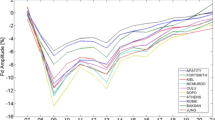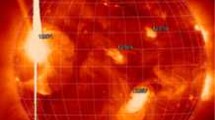Abstract
The Forbush decreases of the cosmic ray intensity observed on 24 December 2014 and on 8 September 2017 were chosen for cosmic ray spectral analysis. At first an analytical study of the solar and geomagnetic parameters of these events was carried out due to the fact that both are typical cosmic ray events. Hourly cosmic ray data of the neutron monitor stations obtained from the high-resolution neutron monitor database were used for calculating the cosmic ray density and anisotropy variations. Following the method of the coupling coefficients, the galactic cosmic ray spectral index was calculated using the technique of Wawrzynczak and Alania (Adv. Space Res. 45, 622, 2010). A newly presented yield function by Mishev, Usoskin, and Kovaltsov (J. Geophys. Res. 118, 2783, 2013) including a geometrical correction factor, already used in the spectral analysis of the cosmic ray ground level enhancements, was applied for the first time to the case of Forbush decreases. A comparison of these results during the events is performed by using two other coupling functions: the function presented in the work of Clem and Dorman (Space Sci. Rev. 93, 335, 2000) and the one in the work of Belov and Struminsky (Proc. 25th Int. Cosmic Ray Conf. 1, 201, 1997). The latter includes an extension for neutron monitor stations with rigidity \(1~\mbox{GV} < R < 2.78~\mbox{GV}\). The obtained spectral index and the calculated cosmic ray intensity in the heliosphere during the two Forbush decreases after the coupling by these three functions are presented and discussed.





Similar content being viewed by others
References
Agostinelli, S., Allison, J., Amako, K., Apostolakis, J., Araujo, H., Arce, P., et al.: 2003, GEANT4 a simulation toolkit. Nucl. Instrum. Methods Phys. Res. A 506, 250. DOI.
Alania, M.V., Wawrzynczak, A.: 2008, Forbush decrease of the galactic cosmic ray intensity: experimental study and theoretical modeling. Astrophys. Space Sci. Trans. 4, 59. DOI.
Alania, M., Wawrzynczak, A.: 2012, Energy dependence of the rigidity spectrum of Forbush decrease of galactic cosmic ray intensity. Adv. Space Res. 50, 725. DOI.
Belov, A.V., Eroshenko, E.A.: 1996, The energy spectra and other properties of the great proton events during 22nd solar cycle. Adv. Space Res. 17, 167.
Belov, A.V., Struminsky, A.B.: 1997, Neutron monitor sensitivity to primary protons below 3 GeV derived from data of ground level events. Proc. 25th Int. Cosmic Ray Conf. 1, 201.
Belov, A.V., Eroshenko, E.A., Livshits, M.A.: 1994, The energy spectra of the accelerated particles near the Earth and in the source in 15 June 1991 enhancement. Proc. 8th Intern. Symp. on Solar Terrestrial Physics Pt. 1, 26.
Belov, A., Eroshenko, E., Mavromichalaki, H., Plainaki, C., Yanke, V.: 2005, Solar cosmic rays during the extremely high ground level enhancement on 23 February 1956. Ann. Geophys. 23, 2281. DOI.
Burlaga, L.F.: 1995, Interplanetary Magnetohydrodynamics, Oxford University Press, New York.
Caballero-Lopez, R.A., Moraal, H.: 2012, Cosmic-ray yield and response functions in the atmosphere. J. Geophys. Res. 117, A12. DOI.
Cane, H.V.: 2000, Coronal mass ejections and Forbush decreases. Space Sci. Rev. 93, 55. DOI.
Clem, J., Dorman, L.: 2000, Neutron monitor response functions. Space Sci. Rev. 93, 335. DOI.
Desorgher, L., Flückiger, E.O., Gurtner, M., Moser, M.R., Bütikofer, R.: 2005, Atmocosmics: a Geant 4 code for computing the interaction of cosmic rays with the Earth’s atmosphere. Int. J. Mod. Phys. A 20, 6802. DOI.
Dorman, L.I.: 1963, Cosmic Rays Variations and Space Exploration, Nauka, Moscow.
Dorman, L.I.: 2004, Cosmic Rays in the Earth’s Atmosphere and Underground, Kluwer, Dordrecht.
Dorman, L.I., Yanke, V.: 1981, The coupling functions of NM-64 neutron super monitor. Proc. 17th Int. Cosmic Ray Conf. 4, 326.
Dorman, L.I., Villoresi, G., Iucci, N., Parisi, M., Tyasto, M.I., Danilova, O.A., Ptitsyna, N.G.: 2000, Cosmic ray survey to Antarctica and coupling functions for neutron component near solar minimum (1996-1997) 3. Geomagnetic effects and coupling functions. J. Geophys. Res. 105, 21047. DOI.
Flückiger, E.O., Moser, M.R., Pirard, B., Bütikofer, R., Desorgher, L.: 2008, A parameterized neutron monitor yield function for space weather applications. In: Caballero, R., D’Olivo, J., Medina-Tanco, G., Nellen, L., Sánchez, F., Valdés-Galicia, J. (eds.) Proc. 30th Intern. Cosmic Ray Conf. 1, 289.
Forbush, S.: 1937, On the effects in cosmic-ray intensity observed during the recent magnetic storm. Phys. Rev. 51, 1108. DOI.
Hatton, C.J.: 1971, The neutron monitor. In: Wilson, J.G., Wouthuysen, S.A. (eds.) Processes in Elementary Particle and Cosmic Ray Physics, North-Holland, Amsterdam, 3.
Hess, V.F., Demmelmair, A.: 1937, World-wide effect in cosmic ray intensity, as observed during a recent magnetic storm. Nature 140, 316. DOI.
Koldobskiy, S.A., Kovaltsov, G.A., Mishev, A.L., Usoskin, I.G.: 2019, New method of assessment of the integral fluence of solar energetic (> 1 GV rigidity) particles from neutron monitor data. Solar Phys. 294(7), 18. DOI.
Kurt, V., Belov, A., Kudela, K., Mavromichalaki, H., Kashapova, L., Yuskhov, B., Sgouropoulos, C.: 2019, Onset time of the GLE 72 observed at neutron monitors and its relation to electromagnetic emissions. Solar Phys. 294(22), 18. DOI.
Lingri, D., Mavromichalaki, H., Belov, A., Eroshenko, E., Yanke, V., Abunin, A., Abunina, M.: 2016, Solar activity parameters and associated Forbush decreases during the minimum between cycles 23 and 24 and the ascending phase of cycle 24. Solar Phys. 291, 1025. DOI.
Livada, M., Papaioannou, A., Mavromichalaki, H.: 2013, Galactic cosmic ray spectrum and effective radiation doses on flights during Forbush decreases. Proc. 11th HelAS Conf., S1-22.
Livada, M., Mavromichalaki, H., Plainaki, C.: 2018, Galactic cosmic ray spectral index: the case of Forbush decreases of March 2012. Astrophys. Space Sci. 363, 8. DOI.
Matthiä, D., Heber, B., Reitz, G., Meier, M., Sihver, L., Berger, T., Herbst, K.: 2009, Temporal and spatial evolution of the solar energetic particle event on 20 January 2005 and resulting radiation doses in aviation. J. Geophys. Res. 114, A08104. DOI.
Maurin, D., Cheminet, A., Derome, L., Ghelfi, A., Hubert, G.: 2015, Neutron monitors and muon detectors for solar modulation studies: interstellar flux, yield function, and assessment of critical parameters in count rate calculations. Adv. Space Res. 55, 363. DOI.
Mavromichalaki, H., Gerontidou, M., Paschalis, P., Paouris, E., Tezari, A., Sgouropoulos, C., Crosby, N., Dierckxsens, M.: 2018, Real-time detection of the ground level enhancement on 10 September 2017 by A.Ne.Mo.S.: System report. Space Weather 16, 1797. DOI.
Mishev, A.L., Usoskin, I.G., Kovaltsov, G.A.: 2013, Neutron monitor yield function: new improved computations. J. Geophys. Res. 118, 2783. DOI.
Mishev, A., Usoskin, I., Raukunen, O., Paassilta, M., Valtonen, E., Kocharov, L., Vainio, R.: 2018, First analysis of ground-level enhancement GLE72 on 10 September 2017: spectral and anisotropy characteristics. Solar Phys. 293, 136. DOI.
Moraal, H., Belov, A., Clem, J.M.: 2000, Design and co-ordination of multi-station international neutron monitor networks. Space Sci. Rev. 93, 285. DOI.
Picone, J.M., Hedin, A.E., Drob, D.P., Aikin, A.C.: 2002, NRLMSISE-00 empirical model of the atmosphere: Statistical comparisons and scientific issues. J. Geophys. Res. 107(A12), 1468. DOI.
Plainaki, C., Belov, A., Eroshenko, E., Mavromichalaki, H., Yanke, V.: 2007, Modeling ground level enhancements: Event of 20 January 2005. J. Geophys. Res. 112, A04102. DOI.
Plainaki, C., Mavromichalaki, H., Laurenza, M., Gerontidou, M., Kanellakopoulos, A., Storini, M.: 2014, The ground level enhancement of 2012 May 17: derivation of solar proton event properties through the application of the NMBANGLE PPOLA model. Astrophys. J. 785, 160. DOI.
Shrivastava, P.: 2005, Study of large solar flares in association with halo coronal mass ejections and their helio-longitudinal association with Forbush decreases of the cosmic rays. Proc. 29th Intern. Cosmic Ray Conf. 1, 355.
Smart, D.F., Shea, M.A., Tylka, A.J., Boberg, P.R.: 2006, A geomagnetic cutoff rigidity interpolation tool: Accuracy verification and application to space weather. Adv. Space Res. 37, 1206. DOI.
Stoker, P.H., Dorman, L.I., Clem, J.M.: 2000, Neutron monitor design improvements. Space Sci. Rev. 93, 361. DOI.
Usoskin, I.G., Braun, I., Gladysheva, O.G., Horandel, J.R., Jamsen, T., Kovaltsov, G.A., Starodubtsev, S.A.: 2008, Forbush decreases of cosmic rays: Energy dependence of the recovery phase. J. Geophys. Res. 113, A07102. DOI.
Wawrzynczak, A., Alania, M.: 2010, Modeling and data analysis of a Forbush decrease. Adv. Space Res. 45, 622. DOI.
Yasue, S., Mori, S., Sakakibara, S.: 1982, Coupling coefficients of cosmic rays daily variations for neutron monitor stations. Rep. Cosmic Ray Res. Lab. 7, Nagoya Univ.
Acknowledgements
Many thanks are due to our collaborators of the neutron monitor stations for kindly providing the cosmic ray data used in this work from the High-resolution real-time Neutron Monitor database (NMDB), funded under the European Union FP7 Program (contract no. 213007). A.Ne.Mo.S. is supported by the Special Research Account of the National and Kapodistrian University of Athens. Thanks are also due to the editor and the anonymous referee of the Solar Physics for useful suggestions.
Author information
Authors and Affiliations
Corresponding author
Ethics declarations
Disclosure of Potential Conflicts of Interest
The authors declare that there is not conflict of interest.
Additional information
Publisher’s Note
Springer Nature remains neutral with regard to jurisdictional claims in published maps and institutional affiliations.
Rights and permissions
About this article
Cite this article
Livada, M., Mavromichalaki, H. Spectral Analysis of Forbush Decreases Using a New Yield Function. Sol Phys 295, 115 (2020). https://doi.org/10.1007/s11207-020-01679-z
Received:
Accepted:
Published:
DOI: https://doi.org/10.1007/s11207-020-01679-z




